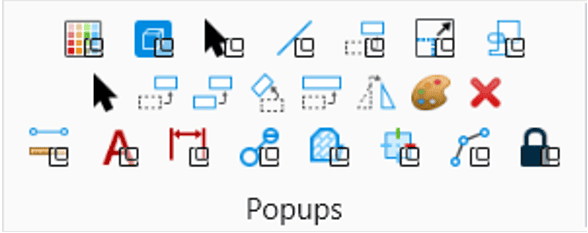Save valuable project time, increase productivity, and streamline your workflow with MicroStation’s default shortcuts! Shortcuts provide easy and quick access to specific ribbon groups or tools – and these default shortcuts can be customized to fit your specific needs.
Function Keys
The Function Key menu contains all the definitions – assignments of actions – for your keyboard’s Function Keys. Function key definitions contain action strings that enable your function keys to perform as you need them to.
The default Function Key menu is funckey.mnu, which is installed in Default Data folder of MicroStation’s program directory.
The Function Keys dialog (File > Settings > User > Function Keys) is used to modify or customize Function Key definitions. You also can define new Function Keys — using the <F1> through <F12> Function Keys along with the <Ctrl>, <Alt>, and <Shift> keys — and add them to your Function Key menus.
To modify a Function Key definition:
- Select Function Keys from File > Settings > User
- The Function Keys dialog opens. The title bar identifies the open Function Key menu.
- Do one of the following:
- Select a Function Key from the list box.
- In the Function Keys group box, turn on the Ctrl, Alt, and/or Shift check boxes and select the desired Function Key from the Function Key Drop-Down List.
- Using the keyboard, press the desired Function Key and the <Ctrl>, <Alt>, and/or <Shift> keys.
- In the Action text box, edit the definition. The definition must be specified as an action string.
- If you wish to save the Function Key menu with a different name or location, click Save As Function Key Menu. The Save Function Key Menu As dialog opens.
- To save the Function Key definitions in the open Function Key menu, click Save. The open Function Key menu is overwritten and the Function Keys dialog closes.
Keytips
Keytips are small keyboard tips that indicate which key to press to access a tab or a tool in the ribbon. Here are four easy steps to get started using keytips:
- With the input focus in Home position, press <F2> to see the keytips for tabs and the Quick Access Toolbar.
- To access the keytips of tools within some other tab, press the keytip for the respective tab after pressing <F2>. For example, to view the keytips for the tools in the Analyze tab, first press <F2> and then <Z>.
- To access the keytips of the tools in the currently displayed tab, press <F3>.
- Press the keytip of the desired tool to activate it. For example, press <TT> to activate the Place Text tool.
Keyboard Shortcuts
Keyboard shortcuts are shortcuts to specific groups or tools in the ribbon. MicroStation supports multi-level keyboard shortcuts. Depending on the key-ins assigned, the tools, ribbon group pop-ups, or pop-up menus are displayed. The keyboard shortcuts can be created, modified, or deleted in the keyboard shortcut s dialog (File > Settings > User > Keyboard Shortcuts).
The default keyboard shortcut for <Space> key contains tools as well as shortcuts for different ribbon groups.
As you can see above, the first row contains ribbon group shortcuts. These are shortcuts for frequently used ribbon groups in the Home tab. Clicking or activating any of them opens the respective ribbon group pop-up. The second row contains frequently used tools. The third row contains shortcuts to frequently used ribbon groups. Each of the icons in the ribbon group have a shortcut key. This shortcut key is displayed when you hover the pointer over the icon. With the ribbon group pop-up displayed, if you press the shortcut key, the respective tool or group activates.
Existing keyboard shortcuts can be modified or deleted, and new keyboard shortcuts can be created in the keyboard shortcuts dialog. Changes to keyboard shortcuts are saved on an XML file. If you want to configure custom keyboard shortcuts and distribute them across a team, then you can do so by configuring them on one machine and then copying the file to other machines.
AccuDraw Shortcuts
Although AccuDraw tries to anticipate your next move it cannot always predict your intentions. AccuDraw therefore includes a wide variety of single- and double-character command directives known as the shortcut key-ins. By pressing the appropriate key, you can direct AccuDraw to perform a specific task. In operation, AccuDraw is the default input focus in most cases, thus letting you just type in the shortcut without having to consider where the input focus is.
Shortcut key-ins are defined as keyboard shortcuts in the keyboard shortcuts dialog. Single letter keyboard shortcuts activate the respective command, while multi-level keyboard shortcuts display a pop-up menu when the first level of keyboard shortcut is pressed. You may then click the desired option from the pop-up menu or press the desired next level keyboard shortcut. You can create, edit, or delete the keyboards shortcuts in the Keyboard Shortcuts dialog.
AutoCAD Commands and Workflows
MicroStation accommodates previous AutoCAD users by supporting AutoCAD commands as Key-ins. This makes users feel at home with MicroStation and ensures a seamless migration for users upgrading their workflows to Bentley.













